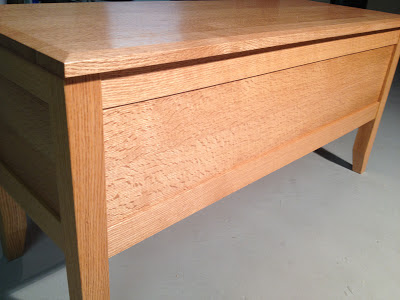This week I finally finished the storage bench that has been in progress on and off for probably 2 years or more. I pre-finished the ship-lapped boards that made up the bottom of the storage area and got them mounted with a few cleats screwed into the inside of the bottom frame. The next step was to add a bevel to the lid which not only adds some visual interest but also removed the dents and gouges around the edge that I inadvertently added while trying to clamp the panel to the face of the work table to plane the edges and end grain. I keep hearing that the key to successful woodworking is finding creative ways to hide your screw-ups. This was one of those challenges. I don't have any router bits for anything like this and cutting this bevel on the table saw seemed risky so I settled on planing the bevel by hand. I marked the start and stop of the bevel on both the top surface and the edge of the lid and then started planing free hand. I used a low angle jack for the ends and the bevel up smoother sharpened to a high angle to deal with some reversing grain on the sides. Overall it was pretty straightforward once I got started and I think it worked out nicely. The bevels are not perfect but they were done by hand and I'm happy with the results.

With the bevel complete I moved on to finishing the lid. I added some cross grain batons to help limit any cupping and then wiped on 4 or 5 coats of polyurethane. As soon as the finish dried I dropped the lid onto the bench to see how it looked.
I ordered some torsion hinges from Rockler to mount the lid. These hinges are similar to those on a laptop. The lid basically stays where you put it so that there are no worries about fingers getting slammed between the lid and the frame.
The hinges were easy to mount and work as advertised.... and now the bench is finally done.
Lessons learned from this project:
1) Even a seemingly simple project takes forever if you don't have time to spend in the shop. I need to make time to work on these projects more consistently.
2) I really enjoy working wood with hand tools and I need to build a real workbench with dog holes and a decent face vise.
3) Carefully selecting wood with appropriate grain patterns for each component of a project makes a huge difference in the finished product.
4) I strongly prefer the straight grained look of quarter and rift-sawn oak compared to the wild patterns of plain-sawn oak.













No comments:
Post a Comment